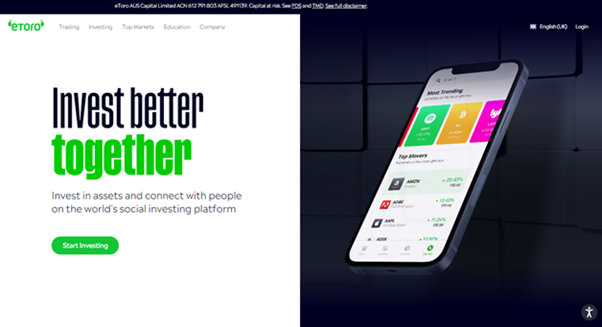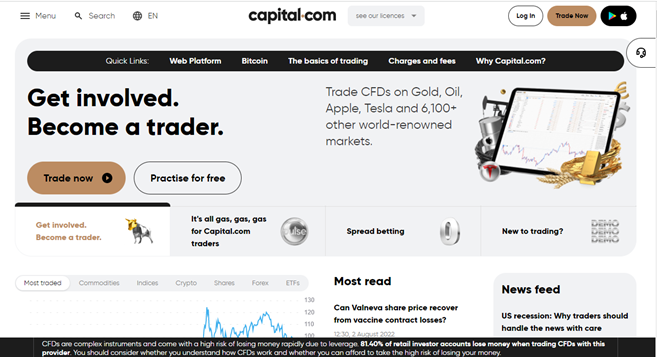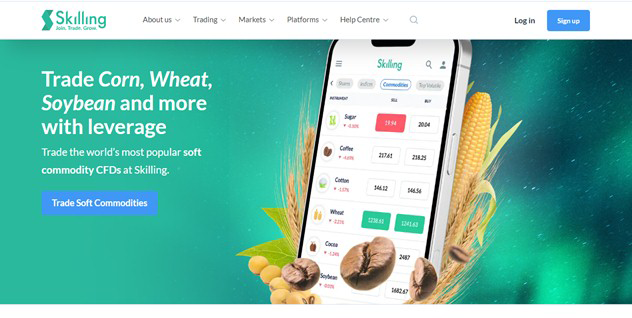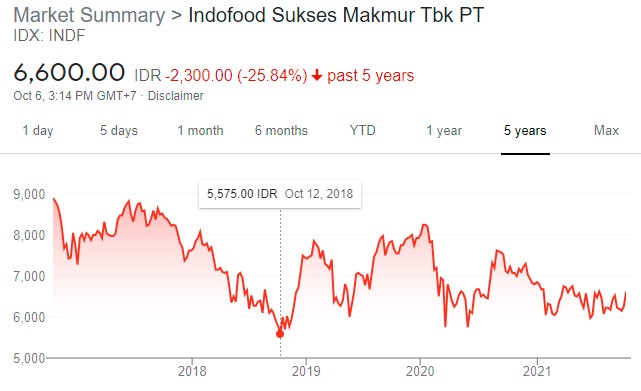How to buy Indofood stocks in 2025

Indofood is an Indonesian food company involved in all stages of food manufacturing, from the production, cultivation and processing of raw materials to the manufacturing of consumer-safe products. The company has many top-selling and well-known brands of noodles, dairy, snack foods, food seasonings, nutrition & special foods, and beverages.
The company, through its many subsidiaries, operates in the flour milling, agribusiness, and distribution industry. The headquarters of the company is located in Jakarta, the capital of Indonesia. Indofood, along with many of its subsidiaries, is listed on the Indonesia Stock Exchange (IDX) under ticker INDF. In the U.S, the company’s stock trades on the over-the-counter market under ticker PIFMY.
The article guides you on buying Indofood stock, explains why you should buy it, and also provides you with in-depth and valuable information about the company.
How to Buy INDF Stocks in 5 Easy Steps
-
1Visit eToro through the link below and sign up by entering your details in the required fields.
-
2Provide all your personal data and fill out a basic questionnaire for informational purposes.
-
3Click 'Deposit', choose your favourite payment method and follow the instructions to fund your account.
-
4Search for your favourite stock and see the main stats. Once you're ready to invest, click on 'Trade'.
-
5Enter the amount you want to invest and configure your trade to buy the stock.
The Best 3 Brokers for Investing in Indofood
1. eToro
eToro is a social trading and investment platform that allows users to trade a variety of assets, including cryptocurrencies. The platform is designed to be user-friendly and intuitive, making it a good choice for those new to investing. eToro also offers some features that can be useful for more experienced investors, such as the ability to copy other traders' portfolios. You can read our full eToro review here.
Security and Privacy
eToro takes security and privacy seriously, offering features such as 2-factor verification and encrypted passwords to keep user accounts safe. The platform also offers a strict anti-money laundering policy to protect users from fraud. To prevent abuse of the platform, they have put several security features in place, such as data loss prevention and restriction of access based on IP address. When a user invests, an additional security feature blocks the transaction from being executed if the account is linked to a potentially fraudulent user. In addition, they employ top vendors, web solutions, and firewalls, constantly on the alert to block a possible cyber-attack.
They take users’ privacy of utmost importance and never share their personal information without their consent.
Fees and Features
One of the most attractive features of eToro is that it is a multi-asset platform which gives access to over 2,000 financial assets like stocks, ETFs, indices, Cryptocurrencies and many more. eToro offers users Free Insurance that would cover claims in case of insolvency or an event of misconduct. Another feature that makes this platform one of the best around is the social trading feature. You can join a community of 20 million traders all around the world and connect with like-minds to shape your trading decisions. Lastly, the CopyTrader feature allows you to use the performance of some seasoned investors to know the one to replicate.
eToro offers 0% commission when you open a long, non-leveraged position on a stock or ETF with no management fees or deposit fees. However, the platform charges an inactivity fee of $10 per month if you don’t trade for 12 months. There is also a low fixed $5 fee for withdrawals.
| Fee Type | Fee Amount |
| Commission Fee | 0% |
| Deposit Fee | None |
| Withdrawal Fee | $5 |
| Inactivity Fee | $10 (monthly) |
Pros
- Security and Privacy
- Low fees and commission
- Copytrading
- Social trading
Cons
- High inactivity fee
- Limited customer service
2. Capital.com
Capital.com offers a variety of investment products and services to its clients. These include stocks, indices, commodities, shares, crypto, and forex. Capital.com has a wide range of clients, including retail investors, institutional investors, and high-net-worth individuals. You can read our full Capital.com review here.

Security and Privacy
Capital.com is licensed by several top regulatory bodies, including the FCA, CySEC, ASIC, and the FSA. This indicates that Capital.com customers are well safeguarded and that the platform adheres to strict guidelines to guarantee that consumer information is secure and hidden. In addition, Capital.com’s compliance with PCI Data Security Standards is another way it safeguards its customers’ information.
Every deposit made by retail customers is protected by the Investment Compensation fund according to regulatory guidelines.
Fees and Features
With CFD trading, customers have access to over 6,000 markets with tight spreads. Capital.com offers educational materials that can help customers to make more informed decisions. Another feature Capital.com offers is Spread betting. This gives customers access to speculate on upward and downward moves on over 3000 markets. The broker provides a tool powered by AI in its mobile trading app that offers individualized trading insights by utilizing a detection algorithm to uncover different cognitive biases.
Capital.com charges no fees on deposit, withdrawal, commission or inactivity.
| Fee Type | Fee Amount |
| Commission Fee | 0% |
| Deposit Fee | None |
| Withdrawal Fee | None |
| Inactivity Fee | None |
Pros
- Tight spreads
- 0% commission with no hidden charges
- Artificial Intelligence
- Risk management tools
- Educational materials
Cons
- Overnight fees
- Mostly restricted to CFDs
3. Skilling
Skilling is an online trading platform that offers users the ability to trade a variety of financial assets, including forex, CFDs, and cryptocurrencies. The platform is designed to be user-friendly and provides traders with all the tools and resources they need to start trading. Skilling also offers a demo account so that users can practice trading before they start trading with real money. You can read our full Skilling review here.

Security and Privacy
The security and privacy of the Skilling online trading platform are taken very seriously. All information entered into the platform is encrypted and stored securely. Only authorized personnel have access to this information. In addition, the platform uses two-factor authentication to ensure that only authorized users can access account information. Skilling is regulated by the Cyprus Securities and Exchange Commission (CySEC), which means customers can rest assured about the security of their assets.
Fees and Features
Skilling has four different platforms; Skilling Trader, Skilling cTrader, Skilling MetaTrader 4 and Skilling Copy. Skilling Trader is designed for traders on all levels with access to all the tools needed for trading analysis. Skilling cTrader on the other hand is designed for advanced traders with a focus on order execution and charting capabilities. MetaTrader 4 is a forex and CFDs trading platform with a very versatile and easy-to-customise interface. Skilling Copy is a copy trading platform which allows members to have access to follow or copy trading strategies of seasoned traders at a fee.
Skilling does not charge any fee for inactivity, deposit or withdrawal. However, there are commission charges on FX pairs and Spot Metals on the Premium account type. These charges start from $30 per million USD traded.
| Fee Type | Fee Amount |
| Commission Fee | Varies |
| Deposit Fee | None |
| Withdrawal Fee | None |
| Inactivity Fee | None |
Pros
- Reliable 24/5 customer support
- Over 1000 trading instruments
- Superb licensing and regulation
- Demo account
Cons
- Not enough educational materials
- High Spreads
- Service is unavailable in many countries including the US and Canada.
Everything You Need To Know About Indofood
Investors analyse and interpret various aspects of the company, including its history, business strategy, revenue sources, financials, and many others before investing in it. In the following sections, we discuss details about the company, which will enable you to understand its business and make the right investment decisions.
Indofood History
Indonesian businessman Sudono Saleem founded Indofood in 1968 as Lambang Insan Makmur as a noodle company. The company was incorporated in 1990 as PT Panganjaya Intikusuma and expanded into the snack foods business. In 1994, it got listed on the Indonesia Stock Exchange.
In the subsequent years, the company continued to make acquisitions to develop its food-related business. In 1995, Indofoods bought Bogasari flour mill as part of its business integration efforts to transform from a noodle company into a total food solution company.
It also acquired companies involved in the plantation, agribusiness, and distribution industries in 1997 to further integrate the business and strengthen its supply chain. In 2005, it entered the shipping business after it acquired a shipping company PT Pelayaran Tahta Bahtera.
In 2008, the company made two more strategic acquisitions: Its agribusiness group acquired PT Lajuperdana Indah and entered into the sugar business, while its Consumer Branded Products (CBP) group bought dairy producer PT Indolakto to venture into the dairy business. Indofood’s subsidiary, Indofood Consumer Branded Products or ICBP, was listed on the Indonesia Stock Exchange in 2010.
In 2013, it further broadened its activity by entering into the beverage business and expanded its sugar business overseas in Brazil and the Philippines through equity investments. In 2014, Indofood also expanded its beverage business and acquired Club company. The company’s acquisition spree and business expansion continued in 2020 as well, as it acquired instant noodle producers with operations in Africa, the Middle East and South-Eastern Europe.
What Is Indofood’s Strategy?
Indofood pursues a business integration strategy that includes horizontal and vertical integration to expand its business and attain self-sufficiency in its value chain. As part of its strategy, the company acquired numerous businesses to fulfil its corporate vision of becoming a total food solutions company with a special focus on accelerating the company’s revenues by buying companies with foreign operations.
The management plans to achieve sustainable growth and create value with the higher operational efficiency of the company’s supply chain. It believes that automation of business processes, better energy management, and waste reduction hold the key to drive the company’s productivity.
How Does Indofood Make Money?
Indofood operates four business groups, namely Consumer Branded Products, Bogasari, Agribusiness, and Distribution. The Consumer Branded Products (CBP) group derives its revenues from the sales of different brands and types of noodles, dairy products, snack foods, food seasonings, nutrition & special foods, beverages, and packaging.
The Bogasari division generates revenues from the sales of flour and pasta under prominent brands. The Agribusiness segment is involved in research & development, seed breeding, plantation of oil palm, rubber, sugar cane, and other crops. It earns revenue by selling edible oils and fats, such as cooking oil, shortening, margarine, and other related products.
The Distribution division earns revenue by delivering consumer products produced by Indofood and third parties to the market using its distribution and logistics network.
How Has Indofood Performed in Recent Years?
Indofood stock lost around 26% over the past five years (between October 2016 and October 2021) as the stock gradually lost ground from 8,900 IDR to its current levels of 6,600 IDR. The stock achieved its lowest point of 5,575 IDR on October 12, 2018, and has since been trading in a range between 6,000 and 8,000 IDR.

Source: Google Finance
Where Can You Buy Indofood Stock?
You need to open an account with a stockbroker to buy Indofood stock. You have the option to open a cash account, margin or leveraged account, retirement account, or any other specialised investment account.
Indofood Fundamental Analysis
Fundamental analysis is the key to determine whether the stock is appropriately valued on the market. To conduct financial analysis, investors use data from the financial statements and stock price of the company to calculate various financial ratios and metrics, which helps them to find out the intrinsic or real value of the stock. The most commonly used financial metrics investors analyze include the P/E ratio, revenue, earnings, earnings-per-share, dividend yield, and cash flow.
Indofood’s Revenue
The revenue of a company represents the amount of money a company received by selling its products or services in a particular period. Companies aim to grow their revenues by diversifying or broadening their revenue sources. Investors closely monitor the growth in revenues to identify companies with high growth potential that could give them a higher return on their investment.
You can find the revenue figure on the income statement of the company. Indofood recorded net sales or net revenue of Rp47.29 trillion in Q2 2021, registering a 20% growth from the last year’s quarter.
Indofood’s Earnings-per-Share
The earnings-per-share or EPS denotes the net profit or earnings available for each share. The metric is calculated by dividing the net profit less prefered dividends, if any, and dividing the result by the average number of common shares outstanding during the period.
The resulting figure is called basic earnings per share, which differs from the diluted earnings-per-share metric that is calculated by including convertible bonds or preferred stocks in the average number of shares outstanding. For example, if the net profit of a company is $50 million and the company has $5 million average common stock outstanding during a period, its EPS would be $10.
Investors prefer investing in stocks that have consistently high EPS growth. In its Q2 2021 financial report, the company reported basic earnings per share of Rp391.
Indofood’s P/E Ratio
The price-to-earnings ratio or P/E ratio measures the stock’s price in relation to its earnings per share. In other words, the metric determines the earnings multiple at which the stock is currently trading. For example, if a stock is trading at $20 per share and has an EPS of $10, its P/E ratio would be 2x. The P/E ratio of 2x shows that the stock is trading twice its earnings per share of $10.
The P/E ratio is usually calculated on a trailing 12-month basis, which means that the EPS of the previous 12 months is taken into account while calculating the ratio. Also, the ratio changes daily with the change in the market price of the stock.
As of October 6 2021, Indofood’s P/E ratio was 8.22x.
Indofood’s Dividend Yield
Dividends are the cash distributions by a company from its profit to its shareholders. The board of directors are authorised to declare dividend payments, as and when they deem fit. In order to be eligible to receive dividends, you need to hold the stock before the ex-dividend date.
Investors use the dividend yield ratio to determine the dividends per share a company paid annually as a percentage of its stock price. For example, if a company paid $10 per share dividends annually while the stock’s current price is $100, the dividend yield would be 10%. The 10% dividend yield means that the company paid 10% of its current stock price as dividends in the previous year.
Stocks that have a high dividend yield can be a good option for investment, but you need to beware that the value of dividend yield depends on the stock’s current price. So, if a stock has plummeted lately while its dividend payments have remained the same, its dividend yield would be overstated.
As of October 6 2021, Indofood’s dividend yield was 4.21%.
Indofood’s Cash Flow
Free cash flow is calculated by deducting the capital expenditures from the company’s operating cash flows. A high amount of free cash flow means that the company is generating enough money from its operations to finance its capital expenditures as well as dividend and interest payments.
You can also view the company’s cash position on its cash flow statement. As of June 30, 2021, Indofood had cash & cash equivalents of Rp15.8 trillion.
Why Buy Indofood Stocks?
Indofood has rapidly expanded its business by integrating companies pivotal to its supply chain. The company is one of the largest companies by market capitalisation in Indonesia and is aggressively expanding its operations in foreign markets as well. Here are some of the reasons why you should consider buying Indofood stock.
- The company has been maintaining a 50% dividend ratio since 2016 and pays out regular dividends, which makes the stock a decent option for dividend investors.
- Indofood is an established brand with an aggressive integration business strategy that can provide you with long-term capital gains, along with dividends.
- The company is a total food solutions company, which means that the company operates in all the stages of food production, from cultivation and processing to manufacturing and marketing. The food industry is relatively invulnerable to economic recession, which means that the company’s revenue can be expected to remain stable because of its business model.
Expert Tip on Buying Indofood Stock
“ Indofood stock has lost around 26% from its five-year highs, which has lowered the stock’s valuation and made it relatively cheaper despite the consistent year-over-year rise in revenues and earnings. This provides an opportunity for value investors to buy the stock now when the price is near its five-year lows. You can see the dips in the price as a buying opportunity to lower your average cost of buying the stock to realise a high total return in the form of capital gains and dividends. ”
5 Things to Consider Before You Buy Indofood Stock
You should consider employing these five important investing tips to significantly improve your returns on investment.
1. Understand the Company
Understanding the company’s business, operations, revenue sources, risks, financial position, and other aspects can help you identify better investment opportunities. Famous investors such as Warren Buffett and Peter Lynch thoroughly analyse a company’s business model and study its financial reports before buying its stock. When you understand the company, you would be able to identify the factors that drive the stock price, allowing you to accurately forecast the direction of the stock.
2. Understand the Basics of Investing
You need to understand and apply the basic principles of investing before investing in a stock. For example, one of the basics of investing is to create a diversified portfolio consisting of different investment vehicles. A diversified portfolio spreads the risk across different assets, which lowers your investment risk. Similarly, if you are into short-term trading, you need to employ risk-management techniques that entail putting strategically placed stop-loss points in all your trades to protect your capital.
3. Carefully Choose Your Broker
Selecting the right stockbroker can give you many advantages, resulting in improved trading performance. You should look for the following important features while selecting a stockbroker:
- Access to a robust and advanced trading platform that can be operated on all platforms and devices.
- Low fees, spreads, and commissions, which reduces your trading costs.
- Access to a large number of financial instruments.
- Should be registered with and regulated by the local regulatory authorities to avoid the risk of losing your capital as a result of the broker’s default.
- Allows easy deposit and withdrawal methods.
4. Decide How Much You Want to Invest
It might be tempting to invest all of your money in a seemingly profitable asset, but investment gurus advise against putting all your money in a single asset. A popular method to invest is the dollar-cost-averaging strategy, which involves investing small amounts of money after regular intervals irrespective of the stock’s price. The strategy reduces the overall cost of buying stocks.
5. Decide on a Goal for Your Investment
Your investment goal determines the type of investment strategy you adopt. An investment goal is usually set keeping in view your age, capital, risk tolerance, and other factors. If you have a high-risk tolerance, you can set a high investment return goal but by assuming a higher risk. Investment goals with a moderate return can be achieved relatively easily by taking a lower risk. If you have less capital, you can't afford to lose it by taking a higher risk and may have to settle for a moderate return objective.
The Bottom Line on Buying Indofood Stocks
Indofood is a vertically integrated food company that is self-reliant in its value chain. The company has strong fundamentals and is one of the famous brands in Indonesia. It also provides its shareholders with healthy dividends and has a 50% payout ratio. The company has been acquiring valuable companies to expand its operations. Recently, the company has started to invest in overseas companies, taking its operations internationally as well.
If you want to buy Indofood stock, you can open an account with a stockbroker that would give you access to the stock market. You can open your account online by inputting your details on an online form and uploading your identity documents, such as proof of residence and your ID card. After your account is created, you can deposit funds into your account using any of the popular deposit methods.
If you want to explore more stocks, you can browse our website for an extensive list of stocks that we covered comprehensively. There are so many educational guides on our website that can provide you with in-depth valuable information on stocks that can aid you in your investment decisions.
Frequently Asked Questions
-
Indofood stock trades on the Indonesia Stock Exchange under ticker INDF. In the U.S, the company’s stock trades on the over-the-counter market under ticker PIFMY.
-
Indofood is exposed to a number of risks, including food safety risk, raw material & commodity price risk, competition risk, global warming & climate change risk, among others. However, the company’s management is fully aware of the risk and has put the necessary systems in place to mitigate the risks to acceptable levels.
-
Indofood stock has been paying out generous dividends consistently for many years, which makes it an appropriate stock for dividend investing. However, the stock is trading at its five-year lows at the time of the writing, which may be an opportunity for value investors to purchase the stock at low levels with a consistent year-over-year rise in earnings and revenues.
-
You need to look into the stock’s P/E ratio, EPS ratio, PEG ratio, the stock’s past performance, and compare the metrics with similar stocks in the industry to determine the intrinsic value of the stock.
-
The 50% dividend payout of Indofood stock means that the company pays out 50% of its net profit or earnings per share as dividends to its shareholders. However, the payout ratio can vary, depending on the dividend policy and decisions of the company’s board of directors.
-
Integration strategy entails acquiring suppliers or key players in its value chain to increase its expertise and safeguard its supply chain. Many companies use the strategy to advance their business and attain self-sufficiency, from the manufacturing of raw materials to the production of finished goods.






